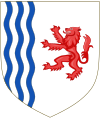New Aquitaine
| Nouvelle-Aquitaine | ||
|---|---|---|
| Region of France | ||
|
||
 |
||
| Country |
|
|
| Prefecture | Bordeaux | |
| Departments | ||
| Government | ||
| • President | Alain Rousset (Socialist Party) | |
| Area | ||
| • Total | 84,061 km2 (32,456 sq mi) | |
| Population (2012) | ||
| • Total | 5,808,594 | |
| • Density | 69/km2 (180/sq mi) | |
| Time zone | CET (UTC+1) | |
| • Summer (DST) | CEST (UTC+2) | |
| Website | www |
|
Nouvelle-Aquitaine (French: [nuvɛl akitɛn], "New Aquitaine"; Occitan: Nòva Aquitània; Basque: Akitania Berria; Poitevin-Saintongeais: Novéle-Aguiéne) is the largest administrative region in France, located in the southwest of the country. The region was created by the territorial reform of French Regions in 2014 through the merger of three regions: Aquitaine, Limousin and Poitou-Charentes. It covers 84,061 km2 (32,456 sq mi) – or 1⁄8 of the country – and has approximately 5,800,000 inhabitants. (municipal population on 1 January 2012). The new region was established on 1 January 2016, following the regional elections in December 2015.
It is the largest region in France by area, with a territory slightly larger than that of Austria; even French Guiana is smaller. Its largest city, Bordeaux, together with its suburbs and satellite cities, forms the 7th-largest metropolitan area of France, with 850,000 inhabitants. The region has 25 major urban areas, among which the most important after Bordeaux are Bayonne (288,000 inhabitants), Limoges (283,000), Poitiers (255,000), Pau (241,000), and La Rochelle (206,000), as well as 11 major clusters. The growth of its population, particularly marked on the coast, makes this one of the most attractive areas economically in France: the new region outperforms the Île-de-France and Provence-Alpes-Côte d'Azur in terms of demographic dynamism.
...
Wikipedia

